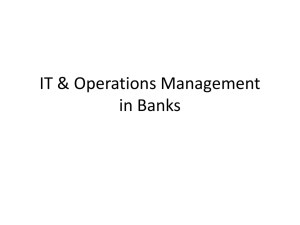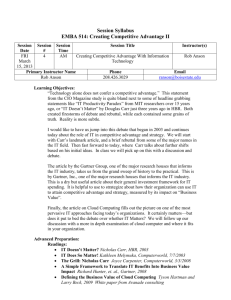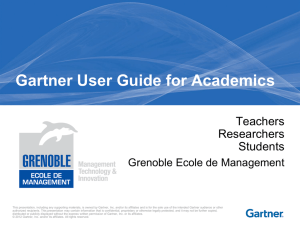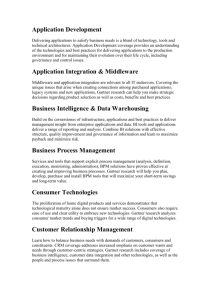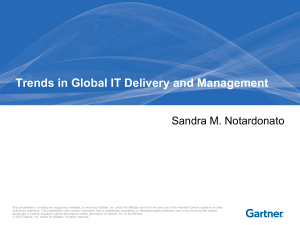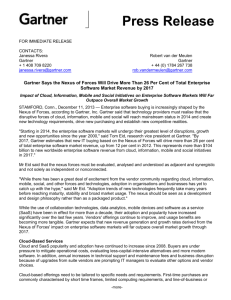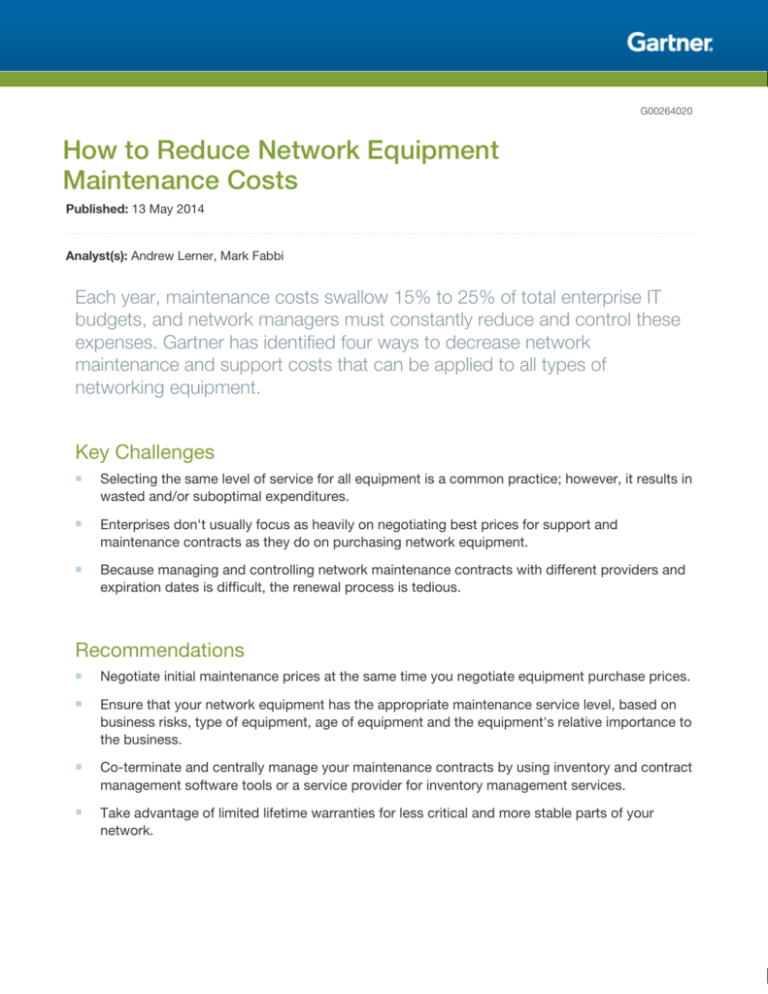
G00264020
How to Reduce Network Equipment
Maintenance Costs
Published: 13 May 2014
Analyst(s): Andrew Lerner, Mark Fabbi
Each year, maintenance costs swallow 15% to 25% of total enterprise IT
budgets, and network managers must constantly reduce and control these
expenses. Gartner has identified four ways to decrease network
maintenance and support costs that can be applied to all types of
networking equipment.
Key Challenges
■
Selecting the same level of service for all equipment is a common practice; however, it results in
wasted and/or suboptimal expenditures.
■
Enterprises don't usually focus as heavily on negotiating best prices for support and
maintenance contracts as they do on purchasing network equipment.
■
Because managing and controlling network maintenance contracts with different providers and
expiration dates is difficult, the renewal process is tedious.
Recommendations
■
Negotiate initial maintenance prices at the same time you negotiate equipment purchase prices.
■
Ensure that your network equipment has the appropriate maintenance service level, based on
business risks, type of equipment, age of equipment and the equipment's relative importance to
the business.
■
Co-terminate and centrally manage your maintenance contracts by using inventory and contract
management software tools or a service provider for inventory management services.
■
Take advantage of limited lifetime warranties for less critical and more stable parts of your
network.
Introduction
Network managers face several challenges in reducing and controlling their operating expenditures
(opex), including negotiating support contracts with vendors, choosing the right level of service for
network components and managing multiple maintenance contracts with different expiration dates
from multiple vendors. Gartner has identified four ways that network managers can reduce their
enterprise network support and maintenance costs. These recommendations can be used for all
types of physical and logical networking equipment, including routers, switches, application delivery
controllers (ADCs) and WAN optimization controllers (WOCs).
Maintenance Options
Several types of support and maintenance options are available for network equipment.
Manufacturer-Branded, Manufacturer-Delivered Support and Maintenance
Some vendors sell this service directly, but most vendors sell it through authorized channel
partners. Examples of this type of support and maintenance contract include Cisco SMARTnet, HP
Foundation Care and Juniper Networks J-Care. One of the major selling points of this type of
support is that customers have direct access to the manufacturer's technical assistance center
when they experience problems. This type of support is predominant in North America and is
typically used by enterprises with experienced IT staffs.
Authorized Service Provider Partner Branded and Delivered Support and Maintenance
This method of network support is also known as co-delivery or collaborative support services. An
authorized service provider provides support to a customer and is officially certified by the
manufacturer. The authorized provider is typically an enterprise's first line of support, takes Level 1
and Level 2 calls, and is ultimately accountable for problem resolution. If unable to solve the
problem, the authorized provider can escalate it to the manufacturer's support team. A typical range
of savings for this type of contract, compared with a manufacturer-branded contract, would be 10%
to 30%.
With these contracts, the end-user organization is typically unable to contact the manufacturer's
technical assistance center directly. One of the main limitations is that the authorized service
provider still has to rely on the manufacturer for advanced support (senior-level technicians,
software fixes, patches and updates). Examples of authorized service providers for network
equipment are IBM, Dimension Data, NEC and Orange Business Services. This type of support has
higher levels of adoption in EMEA, the Asia/Pacific (APAC) region and Latin America.
Independent Service Provider Delivered Support and Maintenance
This is typically known as third-party maintenance (TPM), and is sometimes referred to as
unauthorized maintenance. With these contracts, the end-user organization is unable to contact the
manufacturer's technical assistance center. This model is typically used for older, legacy network
equipment and for hardware support only (not software). This type of support usually comes with a
Page 2 of 8
Gartner, Inc. | G00264020
50% to 60% savings off the net cost for manufacturer-branded support.
Price is not the only consideration when negotiating maintenance with TPM providers. The quality of
support can vary considerably, depending on staff qualification, well-defined escalation processes
and specific geographic reach. Concerns from end-user organizations typically include how to
access software updates or upgrades, the quality of the support provided and the financial viability
of the TPM vendor. Consequently, we recommend that enterprises do their own due diligence.
Self-Support via Hardware Sparing
This option enables enterprises to avoid external maintenance and support costs altogether. In
doing this, the organization forgoes the ability to receive updated technical support from one of the
above options. This requires on-site personnel to perform the hardware swap and is typically limited
to areas of the network that are older, non-mission-critical, commoditized, or have basic and/or
repetitive configurations. This approach often yields a more than 80% savings compared with
manufacturer-branded support. (This assumes 1% of production hardware is spared and accounts
for shipping and opex costs.) However, there is no option to contact technical support for software
issues and/or updates. With this approach, network hardware is considered essentially disposable.
Hybrid Approaches
Some organizations employ a hybrid support strategy that uses two or three of these support types
to further optimize maintenance expenditure. The decision among approaches is typically based on
the location, criticality, type and age of the equipment.
Analysis
Negotiate Initial Maintenance Contract Pricing When You Negotiate Equipment
Purchase Prices
Enterprises often apply less diligence to price negotiations for maintenance contracts than they do
to the purchase of network equipment. We recommend that enterprises negotiate their support and
maintenance contracts when purchasing network equipment. Before selecting network equipment
vendors, consider the total cost of ownership (TCO), including full life cycle service contract prices.
Once the vendor has been selected and the hardware has been purchased, it will often require
support and maintenance; however, at that point, enterprises have little leverage. Furthermore, the
negotiated support/maintenance discount can serve as the basis for future negotiations. For
example, if you negotiated a 30% discount for your maintenance, then you can start future
negotiations at the same level.
More than 80% of vendor maintenance contracts are one- to three-year deals. Although most
vendors provide additional discounts for multiyear commitments, organizations should consider
using these incentives to drive better discounts. However, IT leaders must take into account the
Gartner, Inc. | G00264020
Page 3 of 8
type of equipment being covered and the cost of money. For example, if you get only an additional
1% additional discount for prepaying three years of maintenance, that is probably not a good use of
capital. Conversely, if you're considering a maintenance contract for your data center core
switches, a multiyear contract is a likely to be a good fit, because the useful life of this type of
equipment is more than six years, so you will want to be covered throughout its minimum useful life
(see "Know When It's Time to Replace Enterprise Network Equipment").
Ensure That Network Equipment Has the Appropriate Maintenance Level
One Size Does Not Fit All
Gartner recommends a risk-based approach when applying maintenance and support service levels
to networking hardware/software. Not every device requires the same level of maintenance, and
some require no maintenance at all. Consider how critical that equipment is to the business, and
assess the risk of having a lower level of service. Always consider the type of equipment involved
and the relative impact of its failure on the business.
For example, a large manufacturing enterprise would not want to have a critical access switch that
provides connectivity to hundreds of servers down for half a day, with the estimated time to repair
(ETTR) not scheduled until the next business day. This could stop production at a potentially huge
financial cost. For this specific case, the risk of paying for a low-maintenance level is too high.
Similarly, consider a large retail company with 2,000 stores nationwide and workgroup switches
serving 50 non-VIP users per site. The network has been stable for more than five years, and local
hardware spares are available. In this case, the client could contract for a lower level of service, or
possibly no service, to save money on maintenance expenses. It's also possible to reduce
maintenance contract levels by having redundant pairs of devices or by having spare parts on-site.
Some vendors offer special prices on the purchase of spares, which makes this type of analysis
worthwhile, especially for larger installations.
Enterprises must maintain updated network documentation and inventory, and identify the SLAs
associated with a device to assess the best type of maintenance service level for each network
component. Several network configuration and management tools provide consistent maps of the
network (see "Take a Four-Step Network Configuration and Change Management Approach to
Stem Disasters").
Pricing Ranges
Gartner typically observes the following price ranges for maintenance compared with hardware/
software acquisitions costs:
■
For routers and switches, one year of maintenance typically accounts for 5% to 10% of the
initial net purchase price.
■
For ADCs and WOCs, one year of maintenance typically accounts for 15% to 25% of the initial
net purchase price.
Page 4 of 8
Gartner, Inc. | G00264020
These estimates are based on extended (i.e., discounted) pricing, not list pricing.
The variance in these ranges directly correlates to the level of coverage purchased. Table 1 shows
the levels of maintenance services generally available and their associated uptick, when compared
with a standard offering of eight hours per day/five days a week (8/5) with next business day (NBD)
replacement service. (Support and maintenance levels of service vary among vendors and
geographies.)
Table 1. Common Maintenance Service Levels and Costs
Support and Maintenance Levels of Service
Typical Premium
Above 8/5 NBD
8/5 NBD
—
8/5 NBD on-site
30% to 50%
8/5/four-hour hardware replacement (8/5/4)
40% to 60%
8/5/4 on-site
100% to 120%
24/7/4
60% to 80%
24/7/4 on-site
120% to 140%
24/7/2
100% to 140%
24/7/2 on-site
150% to 180%
Source: Gartner (May 2014)
Co-terminate and Centrally Manage Your Maintenance Contracts
Networks are not static. There's a constant churn of new equipment coming in and old equipment
being repurposed and retired. Managing and controlling maintenance contracts can be challenging,
especially when dealing with a large variety of network devices on many contracts, with separate
vendors and expiration dates.
Vendors usually have their own controls to manage contracts and expiration dates, but tend to use
them primarily at contract renewal. Telecom and networking managers typically use rudimentary
methods to manage their maintenance contracts. An up-to-date, accurate inventory is crucial to
creating a successful maintenance strategy and avoiding problems caused by inadvertent coverage
gaps.
To make it easier to manage the renewal process, we recommend that IT managers negotiate with
the maintenance providers to co-terminate key contracts. In addition, organizations with networks
of more than 1,000 devices should invest in inventory and contract management tools (if their
Gartner, Inc. | G00264020
Page 5 of 8
service providers don't offer them) to help them gain better control and develop good network
maintenance strategies.
A number of telecom expense management (TEM) platforms provide solid asset and inventory
capabilities, along with contract management capabilities. Examples include Tangoe, IBM,
Dimension Data, Telesoft, Veremark and MSDL (see "Critical Capabilities for Telecom Expense
Management"). In addition, most networking vendors offer proprietary inventory tools embedded in
their management platforms. Examples of inventory tools include Cisco Prime, HP Intelligent
Management Center, Juniper Space and Extreme Networks NetSight.
Take Advantage of Limited Lifetime Warranties for Less Critical and More Stable
Parts of Your Network
Limited lifetime warranties are available for some campus and data center switches. Due to
configuration commonality and increased mean time between failures (MTBF), the useful life of this
type of equipment has increased by seven to 10 years (see "Know When It's Time to Replace
Enterprise Network Equipment"). Historically, most network equipment was designed to have an
MTBF of approximately 100,000 hours (roughly 11 years). Failures often occur in power supplies
and fans. Looking at new hardware design, fixed-form-factor switches are being designed with
increased MTBF — in many cases, 200,000 hours or more.
Although organizations can expect reduced support and maintenance costs as a result of limited
lifetime warranties, they should examine the details of these warranties to determine whether they
actually reduce their lifetime support and maintenance costs (see"Network Equipment Lifetime
Warranties: Enterprise Savings or Vendor Marketing?" [Note: This document has been archived;
some of its content may not reflect current conditions.]). For example, some limited lifetime
warranties may exclude power supplies and/or fans, and wireless LAN (WLAN) antennas are often
excluded from limited WAPs warranties. Enterprises need to carefully examine "the fine print" about
what is covered on these often-limited lifetime warranties.
Normally, lifetime warranties include hardware replacement, with shipping arrangements that can
vary from NBD to 10 days. Some vendors require customers to return equipment before the vendor
replaces it. On the technical support side, vendors' limited warranties usually provide support
during weekdays within normal business hours. For some devices, this can suffice. However, it's
important to evaluate the impact that a prolonged failure will have on the network. When the
equipment is a workgroup switch that affects a few dozen users at most, the risk may be minimal,
especially when local spares are available. However, risk escalates rapidly when the failure involves
a core switch or a router that can impair major portions of a network. Similarly, a the failure of a
device such as an ADC can cause key applications to go down.
When a business depends on network infrastructure for business continuity, lifetime warranties on
selected network devices may not suffice. For mission-critical and/or nonresilient network
components, we recommend standardizing on higher levels of maintenance and on-site coverage
when skilled network engineers are scarce. However, managers must take into consideration
differences across geographies, because some regions may lack higher support and maintenance
service levels. In some locations, enterprises may depend on independent service providers for
repair or hardware replacement.
Page 6 of 8
Gartner, Inc. | G00264020
Organizations that require 24/7 coverage, or any on-site coverage, will need to purchase an
upgraded service package. Examine the details of the program, whether it maps to the support
needed to meet your requirements and whether it matches the SLAs required by your business.
Looking Ahead
Several current trends are disrupting the networking equipment market, including software-defined
networking, network disaggregation and white-box switching (see "Ending the Confusion About
Software-Defined Networking: A Taxonomy"). Although these technologies are at least 18 months
away from significant mainstream adoption, these trends can lead to:
■
New paradigms in how organizations manage the network hardware life cycle (i.e., disposable,
fit-for-purpose hardware)
■
New vendor maintenance/support models
This should ultimately lead to new opportunities for reduced and optimized maintenance costs (see
"Dell and Cumulus Networks Aim to Take 'BYO Switching' Mainstream").
Gartner Recommended Reading
Some documents may not be available as part of your current Gartner subscription.
"Toolkit: Sample RFP for Data Center Network"
"Toolkit: RFP Template for Wireless LAN"
"Toolkit: Sample RFP for Application Delivery Controllers"
"RFP Template for WAN Optimization Controllers"
"Clients That Don't Segment Their Network Infrastructure Will Have Higher Costs and Increased
Vendor Lock-in"
Gartner, Inc. | G00264020
Page 7 of 8
GARTNER HEADQUARTERS
Corporate Headquarters
56 Top Gallant Road
Stamford, CT 06902-7700
USA
+1 203 964 0096
Regional Headquarters
AUSTRALIA
BRAZIL
JAPAN
UNITED KINGDOM
For a complete list of worldwide locations,
visit http://www.gartner.com/technology/about.jsp
© 2014 Gartner, Inc. and/or its affiliates. All rights reserved. Gartner is a registered trademark of Gartner, Inc. or its affiliates. This
publication may not be reproduced or distributed in any form without Gartner’s prior written permission. If you are authorized to access
this publication, your use of it is subject to the Usage Guidelines for Gartner Services posted on gartner.com. The information contained
in this publication has been obtained from sources believed to be reliable. Gartner disclaims all warranties as to the accuracy,
completeness or adequacy of such information and shall have no liability for errors, omissions or inadequacies in such information. This
publication consists of the opinions of Gartner’s research organization and should not be construed as statements of fact. The opinions
expressed herein are subject to change without notice. Although Gartner research may include a discussion of related legal issues,
Gartner does not provide legal advice or services and its research should not be construed or used as such. Gartner is a public company,
and its shareholders may include firms and funds that have financial interests in entities covered in Gartner research. Gartner’s Board of
Directors may include senior managers of these firms or funds. Gartner research is produced independently by its research organization
without input or influence from these firms, funds or their managers. For further information on the independence and integrity of Gartner
research, see “Guiding Principles on Independence and Objectivity.”
Page 8 of 8
Gartner, Inc. | G00264020

